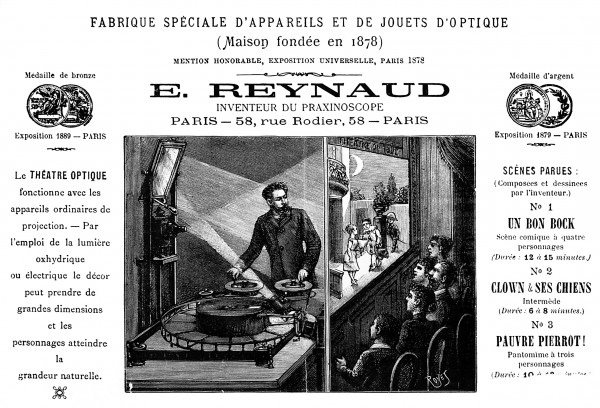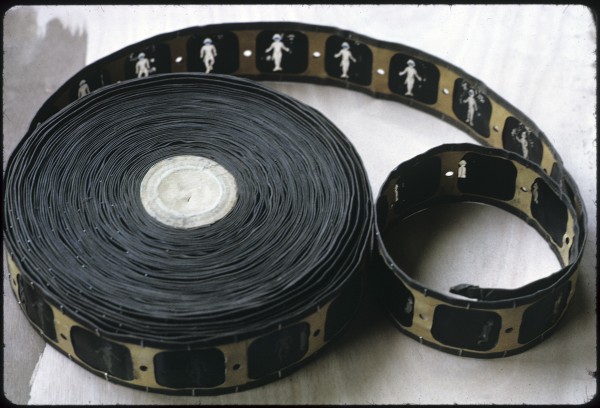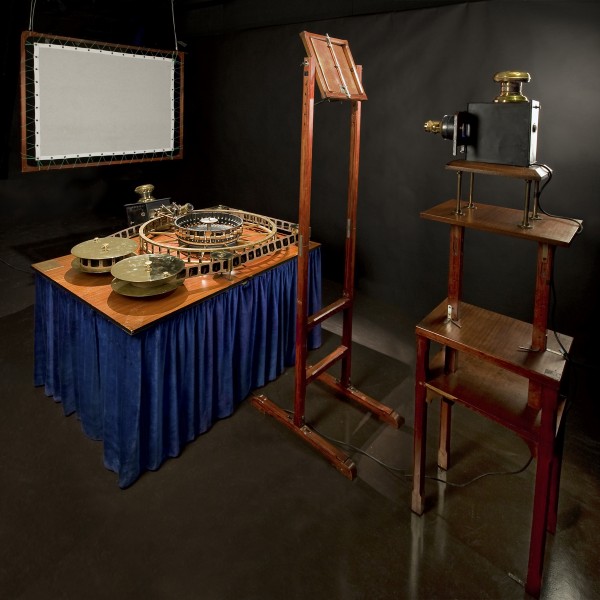Émile Reynaud’s “Théâtre optique” projected entirely hand-painted Pantomimes lumineuses (“Luminous Pantomimes”) onto a screen using a long 70mm perforated strip, running horizontally and projected with rotating prismatic mirrors.
Film Explorer

Autour d’une cabine (1894).
Cinémathèque française, Paris, France.
Identification
60mm x 60mm (2.362 in x 2.362 in).
A round perforation 6mm (0.236 in) in diameter between each image.
The image was applied to gelatin, covered with a layer of carbon black (India ink) and shellac varnish. Color was applied using aniline dyes.
Each image was often numbered by hand, in pencil.
Both forwards and backwards.
1
Colors were applied by hand using aniline dyes.
Acoustic effects accompanied the projection, employing a system of electrical contacts, placed at specific points along the strip, which triggered small drums, and other sound devices.
History
The Théâtre optique (“Optical Theater“) was a device designed in Paris by the French Emile Reynaud (1844–1918). From 1892 to 1900, it was used to entertain Parisians with lengthy shows of Pantomimes lumineuses (“Luminous Pantomimes”) – animated color and sound projections made up of hand-painted images on a long perforated strip. The large “Optical Theater” projector was the culmination of a series of smaller iterations of optical toys created by Reynaud starting in 1877: the Praxinoscope (1878), the Praxinoscope-theater (1879) and the Projection Praxinoscope (1882). All were based on the same principle: “optical compensation” – shuttering by prismatic mirrors.
The Théâtre optique was patented by Émile Reynaud on December 1, 1888, in a rather primitive form. It would undergo successive improvements until 1892: “The purpose of the device is to achieve the illusion of movement no longer limited to the repetition of the same poses at each turn of the instrument, as necessarily occurs in all known devices (zoetropes, praxinoscopes, etc.), but having, on the contrary, indefinite variety and duration, and thus producing truly animated scenes of unlimited development. Hence the name Optical Theater given by the inventor of this device” (Patent no. 194,482, dated December 1, 1888 for “the Optical Theater”).
Music was specially composed by Gaston Paulin for the show. Synchronized acoustic effects accompanied the sketches, thanks to an ingenious system of electrical contacts placed at specific points along the strip, which triggered small drums and other sound devices.
On October 11, 1892, Reynaud signed a contract, to show his Pantomimes lumineuses, with Gabriel Thomas, director of the Musée Grévin, the famous wax figure museum located at 10 Boulevard Montmartre, Paris, and founded by Arthur Meyer and Alfred Grévin in 1881.
The first showing of Pantomimes lumineuses took place on October 28, 1892, in the cabinet fantastique on the museum’s 1st floor. The show was a hit, but the management of the Musée Grévin was extremely demanding. Reynaud was unable to renew his homemade strips, which wore out as the shows went on. He was forced to interrupt his show for several months, from March to December 1894, to finalize Un rêve au coin du feu and Autour d'une cabine. The last showing of Pantomimes lumineuses took place on March 1, 1900, after an eight-year run and some 13,000 showings.
Around 1913, in a fit of despair, Émile Reynaud destroyed the only surviving model of the Théâtre optique. He threw five of its long, hand-painted strips into the Seine river. However, copies of Autour d'une cabine and Pauvre Pierrot! were preserved by his two sons.
The Pantomimes lumineuses by Émile Reynaud was registered in the UNESCO “Memory of the World” Register in 2015.
Selected Filmography
A comic scene presented at the Musée Grévin between December 1894 and March 1900 (10,000 showings). 636 hand-painted images on a 45m (147.6-ft) strip, lasting around 15 minutes. The misfortune of a “Copurchic”, a voyeur who tries to court a pretty bather, but is thrown into the sea by her infuriated husband. Film preserved by the Cinémathèque française. The last scene, showing a boat with the inscription “la représentation est terminée” (“the performance is over”) on its sail, is preserved in the Prague Museum of Technology, Praha, Czechia.
A comic scene presented at the Musée Grévin between December 1894 and March 1900 (10,000 showings). 636 hand-painted images on a 45m (147.6-ft) strip, lasting around 15 minutes. The misfortune of a “Copurchic”, a voyeur who tries to court a pretty bather, but is thrown into the sea by her infuriated husband. Film preserved by the Cinémathèque française. The last scene, showing a boat with the inscription “la représentation est terminée” (“the performance is over”) on its sail, is preserved in the Prague Museum of Technology, Praha, Czechia.
A comic scene presented at the Musée Grévin from October 28, 1892. 700 images painted between 1888 and 1892 on a 50m (164-ft) strip, lasting 12 to 15 minutes. An idle gentleman courts a pretty maid in a bistro. As soon as his back is turned, a kitchen boy takes advantage of the situation to drink his beer. Film destroyed.
A comic scene presented at the Musée Grévin from October 28, 1892. 700 images painted between 1888 and 1892 on a 50m (164-ft) strip, lasting 12 to 15 minutes. An idle gentleman courts a pretty maid in a bistro. As soon as his back is turned, a kitchen boy takes advantage of the situation to drink his beer. Film destroyed.
An interlude presented at the Musée Grévin between November 1892 and February 1894. 300 images hand-painted in 1890 on a 22m (72.2-ft) strip, lasting about 10 minutes. Circus dogs jump on a ball, or jump through hoops. Film destroyed.
An interlude presented at the Musée Grévin between November 1892 and February 1894. 300 images hand-painted in 1890 on a 22m (72.2-ft) strip, lasting about 10 minutes. Circus dogs jump on a ball, or jump through hoops. Film destroyed.
A pantomime presented at the Musée Grévin between November 1892 and February 1894. 500 hand-painted images on a 36m (118.1-ft) strip, lasting 15 minutes. The misfortunes of Pierrot, who tries to court Colombine, but is beaten by Harlequin. Film preserved. Original strip in the collection of the Musée des arts et métiers, Paris.
A pantomime presented at the Musée Grévin between November 1892 and February 1894. 500 hand-painted images on a 36m (118.1-ft) strip, lasting 15 minutes. The misfortunes of Pierrot, who tries to court Colombine, but is beaten by Harlequin. Film preserved. Original strip in the collection of the Musée des arts et métiers, Paris.
A comic scene presented at the Musée Grévin from December 1894 to July 1897. 400 hand-painted images on a 29m (95.1-ft) strip, lasting 12 minutes. Nightmare of a partygoer falling asleep in front of the fireplace: the fire genie conjures up memories of his past life. Film destroyed.
A comic scene presented at the Musée Grévin from December 1894 to July 1897. 400 hand-painted images on a 29m (95.1-ft) strip, lasting 12 minutes. Nightmare of a partygoer falling asleep in front of the fireplace: the fire genie conjures up memories of his past life. Film destroyed.
Technology
The Théâtre Optique was an enlarged and perfected version of the Praxinoscope Projection device. It worked with a long, flexible, perforated strip containing a series of successive hand-painted frames. It was wound and unwound on a spool. Émile Reynaud refused to use photography and instead painted 6cm x 6cm (2.362 in x 2.362 in) images, one-by-one, on each strip. The strips were uniformly perforated with a round hole centered between each image. The strip was wound onto a horizontal spool, placed within easy reach of the operator. The strip ran in front of a magic lantern lens, advanced by a large perforated cylinder fitted with protruding pins, designed to engage with the perforations in the strip. The strip remained under tension at all times, supported by three rollers positioned along its path. The strip could move forwards or backwards, depending on the projectionist's choice. The lantern's light beam passed through each transparent image, which was then reflected by a rotating “cage of mirrors”, made up of 36 mirrors. A fixed mirror captured the animated drawings reflected by the prisms, directing the animated scene through a lens, projecting the images onto another mirror mounted on a wooden frame, which could be oscillated by hand. This mirror reflected the Pantomimes lumineuses onto a screen – its mobility made it possible to move the characters across the screen in line with their apparent movements. Finally, another magic lantern projected a fixed background, against which the characters moved.
Autour d'une cabine, shown at the Musée Grévin in 1894, contains 636 poses on a 45m strip. Microspectrophotometry of a sample has shown that the support for the images is made of gelatin, coated with a layer of carbon black (India ink) and shellac varnish. The aniline colors used were the same as for the ubiquitous magic lantern glass slides.
The 6cm x 6cm images were placed end-to-end on a ribbon of double thread, at the top and bottom, and separated by same-size squares of black cardboard. The round perforation was placed between each image. The strip was 7cm (2.756 in) high and 2mm (0.079 in) thick, and weighed approximately 3.2kg. The rolled strip had an outer diameter of 38cm (14.96 in) and a 7cm (2.756 in) inner diameter.
The strip was made up of a metal skeleton, with the images sandwiched between two layers of paper – all attached between two braided ribbons by metal fasteners. Regularly-spaced perforations were made through the metal and paper to allow the strip to unwind on the pins of the Théâtre optique. Autour d'une cabine is a composite object. It is made up of organic materials of animal origin – gelatin, shellac (varnish); of vegetal origin – cardboard paper, linen paper, cotton (braid); as well as inorganic materials – iron and non-ferric metals. Two types of adhesive film, transparent and black linen, appear at various points along the strip, in contact with the linen paper, cardboard, or gelatin windows.
References
Auzel, Dominique (1992). Émile Reynaud, et l’image s’anima, Paris: Éditions du May.
Lonjon, Bernard (2007). Émile Reynaud, Le véritable inventeur du cinéma, Polignac: Éditions du Roure.
Mannoni, Laurent & Donata Pesenti Campagnoni (2009). Lanterne magique et film peint, 400 ans de cinéma. Paris: Cinémathèque française, Éditions de La Martinière.
Noverre, Maurice (1926). La Vérité sur l’Invention de la Projection animée, Émile Reynaud, sa Vie et ses Travaux. Brest, Bretagne: Imprimé pour l’Auteur, Le Nouvel art cinématographique, 4, Premier cahier.
Sadoul, Georges [Paul Reynaud] (1946). Les Maîtres du cinéma, Émile Reynaud, peintre de films, 1844-1918, Paris: Édité par l’Office français d’édition, Cinémathèque française.
Patents
Reynaud, Émile. Appareil dit Théâtre optique. French patent BF 194 482, filed December 1, 1888, and issued January 14, 1889. Additions made January 6 and August 26, 1889.
Compare
Related entries
Author
Laurent Mannoni is Scientific Director of Heritage and Director of the Conservatoire des Techniques at the Cinémathèque Française, Paris. Author of a doctoral thesis on motion recording in the 19th century, he has published some 20 works, including: Le Grand art de la lumière et de l'ombre (1994), Etienne-Jules Marey, la mémoire de l'œil (1999), Lettres d'Etienne-Jules Marey à Georges Demenÿ (with Thierry Lefebvre and Jacques Malthête (2000), Mouvements de l'air, Etienne-Jules Marey photographe des fluides (with Georges Didi-Huberman (2004), Histoire de la Cinémathèque française (2006), L'œuvre de Georges Méliès (with Jacques Malthête) (2008), Lanterne magique et film peint (with Donata Pesenti Campagnoni) (2009), Tournages, Paris - Berlin - Hollywood, 1910-1939 (with Isabelle Champion) (2010), Alice Guy, Léon Gaumont et les débuts du film sonore (with Maurice Gianati) (2012), Les Enfants du Paradis (with Stéphanie Salmon) (2012), Georges Méliès, la magia del cine (2013), La Machine cinéma (2016), Méliès, La magie du cinéma (2020), Objectif mer, l'océan filmé (2023). He has produced around fifteen exhibitions on these subjects.
Mannoni, Laurent (2024). “Pantomimes lumineuses du Théâtre optique”. In James Layton (ed.), Film Atlas. www.filmatlas.com. Brussels: International Federation of Film Archives / Rochester, NY: George Eastman Museum.
Margaux Chalançon





